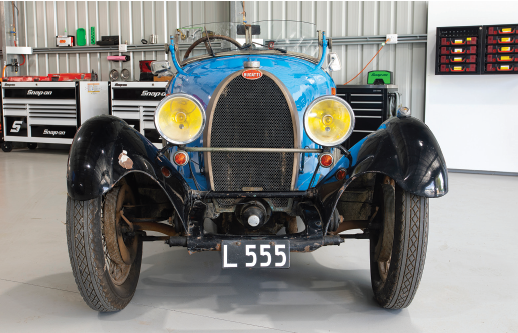What’s it like to restore and maintain classics often worth millions of dollars? We visit a private Queensland workshop established to work on some of the world’s most valuable.
It’s quite peaceful now, but not for much longer. In the expansive 20x20m shed sits a 1931 Bugatti Type 40A Tourer in need of some tidying. Beside it, a 1937 Jaguar Tourer missing its engine, bonnet and floor. Both are exceptional pre-war classics worth a pretty penny, and both a very small part of one of the largest car collections in Australia.
Somewhere in Queensland – it’s being kept hush for now – there’s the promise of the largest car museum in the Southern Hemisphere. The numbers are exceptional. Apparently over 500 classics ranging from the 1880s through to modern day, with an emphasis on luxury, rarity and world class high-end (and value) cars. Add motorcycles, tractors and tanks and it all sounds rather overwhelming.

While plans and work for the facilities are underway, the proposed museum’s workshop is already operational. Dylan Higgins is the museum’s curator and head of engineering, and he brings with him a wealth of experience from working on high-value classics and modern supercars There’s a separate workshop where metal forming and shaping is done, where I spy the missing front guards from a ’37 Bugatti 57 receiving attention. “Reshaping or bending an old guard back straight again is a dying art form,” said Dylan. “It’s a large part of what we do with the cars in the collection; paint and panel takes a long time. People watch shows online and think restoration can be done in a very short period of time, but reality is it can be painstakingly time consuming.”
Working on such vehicles often requires tools and equipment of similar vintage to the cars themselves. Dylan said they have a lathe, milling machine, English wheel, bead blaster, parts washer, shrinker stretcher, finishing hammer, and a 3-in-1 Pressbreak sheet metal folder, guillotine and roller. There’s even a beautifully restored Millennium engine stand to handle those old, ludicrously heavy engine blocks. No, you probably won’t find this sort of kit at your local Toyota service centre.

Dylan gave me a quick sample of the proposed museum’s inventory, and it’s clear the restoration workshop needs the very best equipment. There are pre-war Mercedes-Benz 500k, 540K Cabriolets and a 770K; a Rolls-Royce Silver Ghost; Princess Margaret’s 1954 Rolls-Royce Phantom IV; a 1937 Bugatti Type 57 and a 1939 Bugatti Type 57 Stelvio Cabriolet. Add to that numerous Bentleys, Alfas, Citroens, Ferraris, Auto Unions and early Australian cars and we’re talking in the hundreds of millions of dollars’ worth.
Is Dylan daunted? “It’s amazing to work with this calibre of cars,” he explained. “For me, it’s like being a kid in a candy store with such high-end stuff. When I see them all in their current storage facility it is daunting, and it does sometimes make it hard to sleep at night. You can’t stop thinking about them and the need to find parts. There’s a lot of research involved but I love a challenge, and don’t like being beaten by things.”

The 1937 Bugatti 57 is currently receiving a full panel and paint restoration as well as a mechanical “tidy-up” as Dylan calls it. The blue 1931 Bugatti has been in storage since being bought at a Danish auction in 2012, and the team is considering options for this beauty. “We’re contemplating a full groundup nut and bolt restoration,” Dylan said. “It’s been painted at some point, but the leather upholstery appears original.” As we know, things are only original once, so hopefully the cabin can be tidied and preserved rather than replaced.
The workshop will soon go into overdrive when two spray booths and two new hoists arrive. A separate shed is to be built to house one of the spray booths and an engine room, plus, Dylan hopes, a rolling road as well.
He’s a busy man, but a contended one. He’s always had a passion for these old cars and said there will be an increasing amount of work in the restoration field in future. “The way cars are going electric these days, restoring cars of yesteryear will be seen as even more important,” he said. “They have a sentimental value. I just wish all the cars could tell stories of their histories, of where they’ve been and what they’ve done.”

While there are many opportunities in the car restoration business, Dylan said those interested in it as a career must have a certain mindset. “It’s not like a nine-to-five service workshop, and you must have patience. You need an active mind, to not rush things and take photos and document the disassembly. You must have a passion, plus finesse and pride in your work. I’ve seen people wanting to get into it but end up rushing the work. You can’t slap these sorts of cars back together as a finished product.”
Dylan said he’s recently purchased 100 rotating car stands plus a further 14 lifting and rotating car stands for the museum, showing things are progressing apace. It’s incredible to think 500 classics could one day be housed in the same mighty museum, but Dylan seems ready for whatever the future holds. Classic car restoration? It looks a very safe bet for guaranteed employment in Australia these days.


